Abstract
Paternal or maternal deletions in the 15q11.2-q13 region are known to result in Prader-Willi syndrome (PWS) or Angelman syndrome (AS), respectively. Maternal duplications in 15q11.2-q13 have been found in patients with autism. A population of adults with moderate to profound mental retardation was studied to examine the usefulness of PCR based molecular methods in screening for proximal chromosome 15 abnormalities. Two hundred and eighty-five subjects were initially screened at five microsatellite markers with average heterozygosity values of 0.74 (range 0.54-0.82). Of these subjects, four had a single allele at all five loci, suggestive of a deletion or uniparental isodisomy. The four samples were further screened with additional markers located within 15q11.2-q13 as well as markers telomeric to this region. One subject had uniparental disomy (UPD) and three subjects had a deletion. To determine the parental origin of the 15q11-q13 region containing the single haplotype, samples were analysed with a newly developed methylation specific PCR technique at the SNRPN locus. Each of the four subjects showed presence of the paternal allele and absence of the maternal allele. All cases had a phenotype consistent with Angelman syndrome as expected for the level of mental retardation, but the subject with UPD was distinct from the other subjects with an absence of a history of seizures and presence of bilateral undescended testes and Parkinsonism. Although Angelman syndrome has an estimated population prevalence of 0.008%, at least 1.4% of the moderately to profoundly mentally retarded subjects screened were found to have Angelman syndrome.
Full text
PDF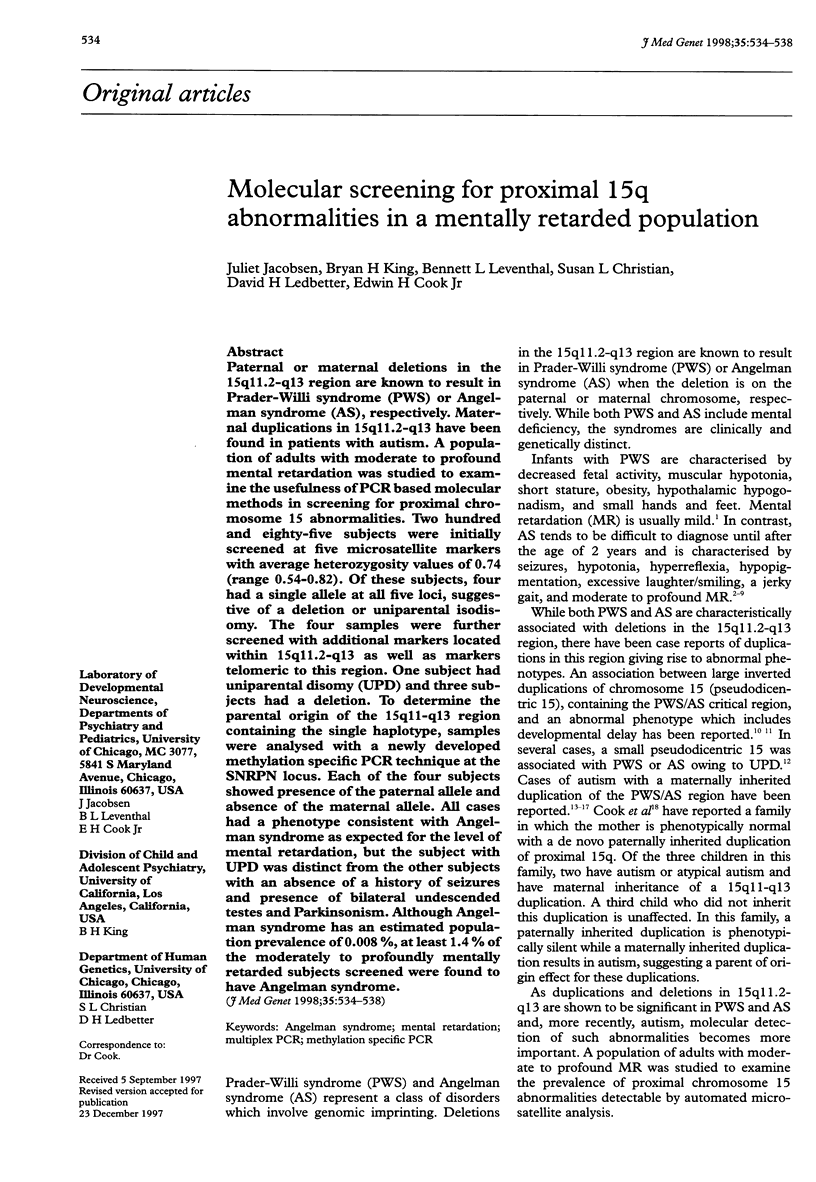
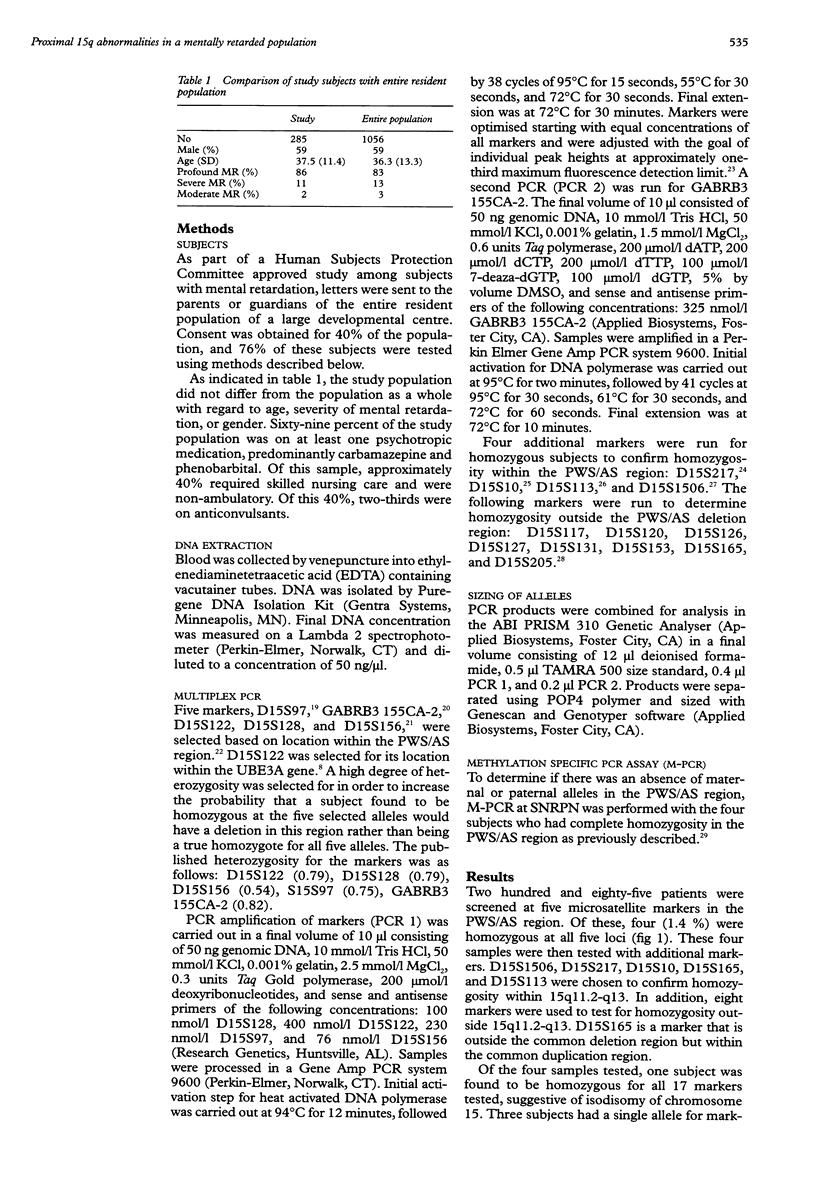
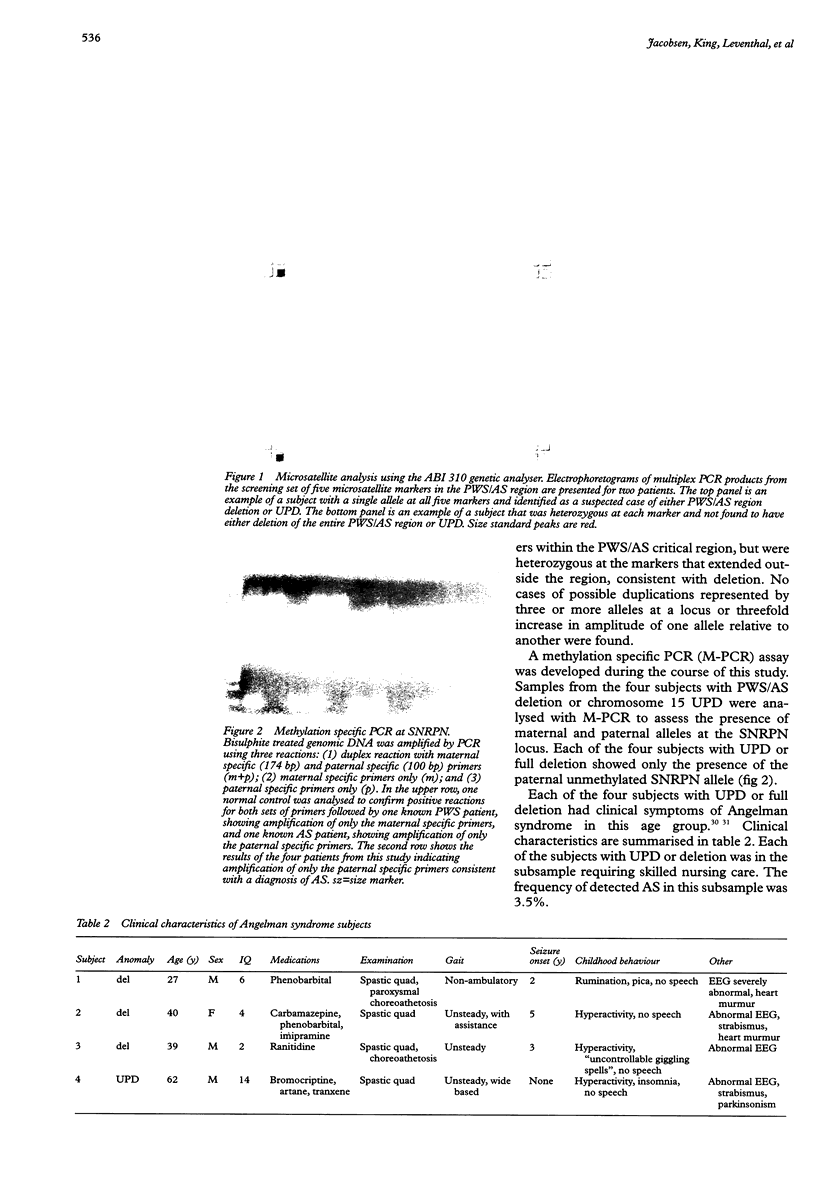
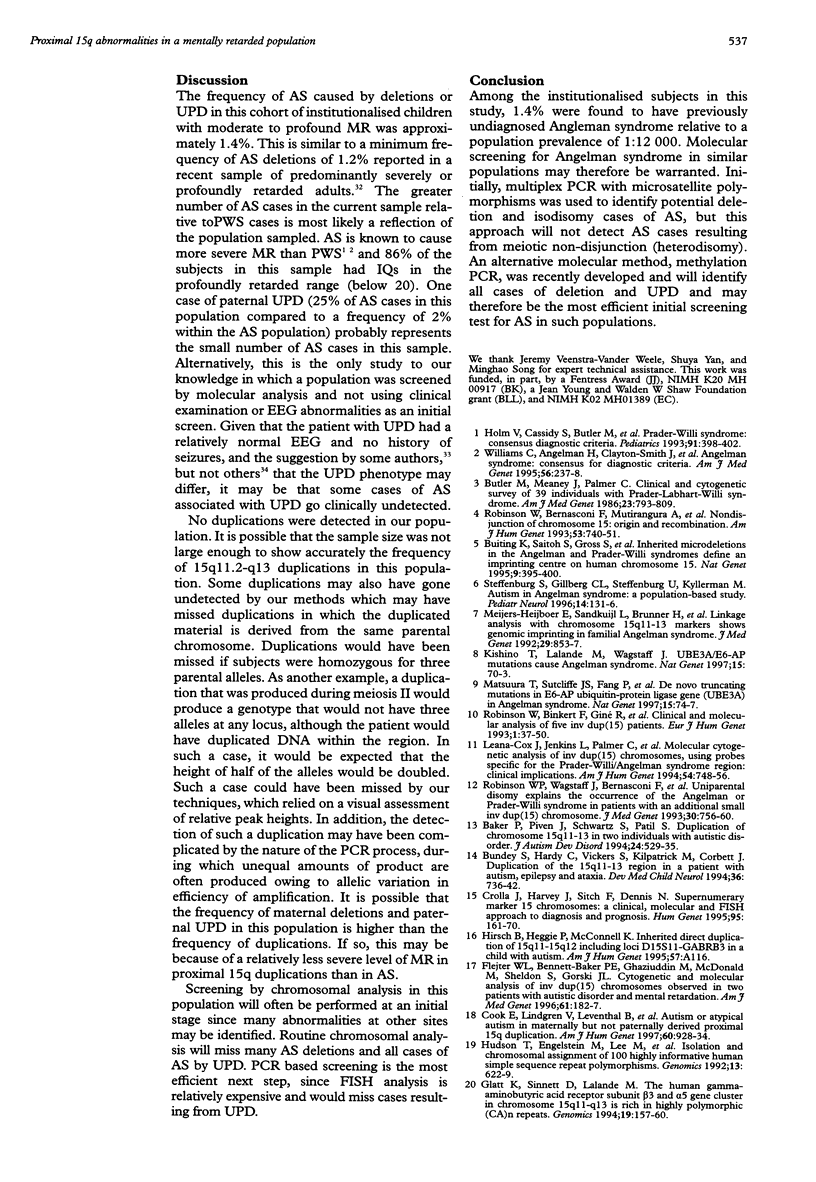
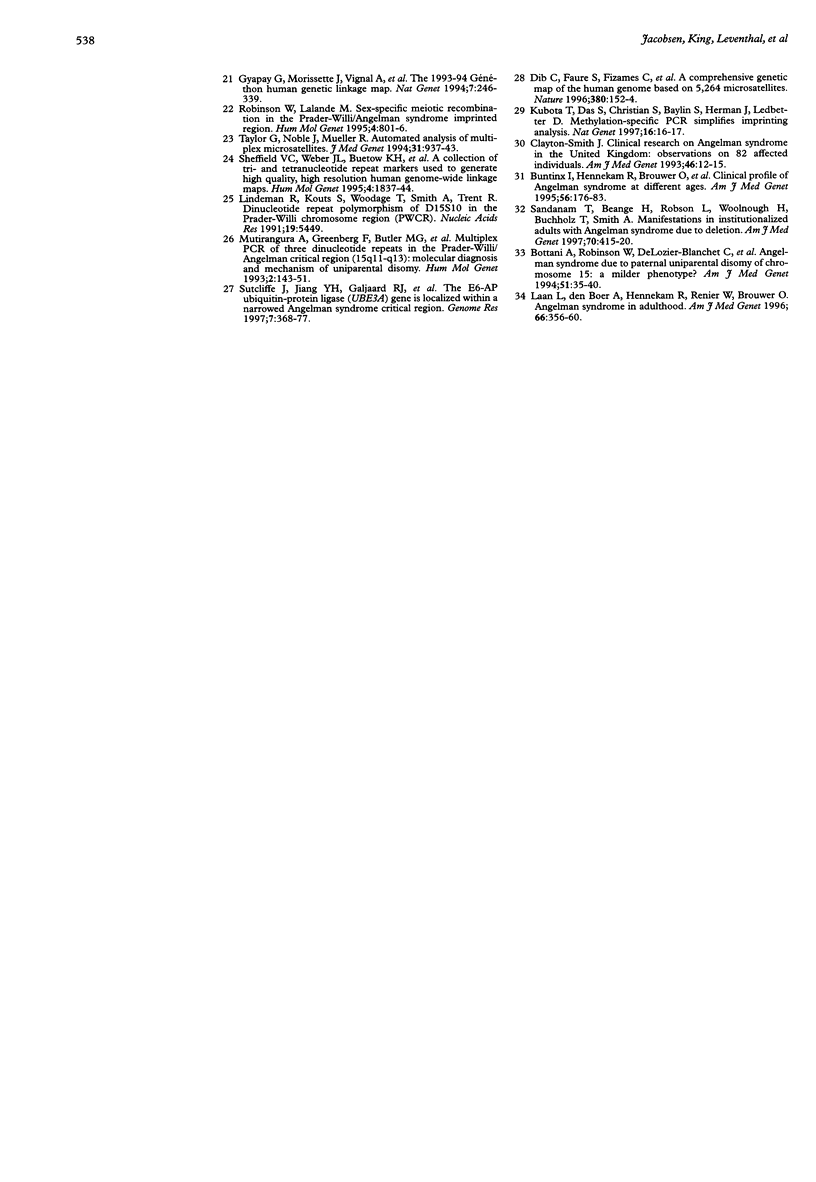
Images in this article
Selected References
These references are in PubMed. This may not be the complete list of references from this article.
- Baker P., Piven J., Schwartz S., Patil S. Brief report: duplication of chromosome 15q11-13 in two individuals with autistic disorder. J Autism Dev Disord. 1994 Aug;24(4):529–535. doi: 10.1007/BF02172133. [DOI] [PubMed] [Google Scholar]
- Bottani A., Robinson W. P., DeLozier-Blanchet C. D., Engel E., Morris M. A., Schmitt B., Thun-Hohenstein L., Schinzel A. Angelman syndrome due to paternal uniparental disomy of chromosome 15: a milder phenotype? Am J Med Genet. 1994 May 15;51(1):35–40. doi: 10.1002/ajmg.1320510109. [DOI] [PubMed] [Google Scholar]
- Buiting K., Saitoh S., Gross S., Dittrich B., Schwartz S., Nicholls R. D., Horsthemke B. Inherited microdeletions in the Angelman and Prader-Willi syndromes define an imprinting centre on human chromosome 15. Nat Genet. 1995 Apr;9(4):395–400. doi: 10.1038/ng0495-395. [DOI] [PubMed] [Google Scholar]
- Bundey S., Hardy C., Vickers S., Kilpatrick M. W., Corbett J. A. Duplication of the 15q11-13 region in a patient with autism, epilepsy and ataxia. Dev Med Child Neurol. 1994 Aug;36(8):736–742. doi: 10.1111/j.1469-8749.1994.tb11916.x. [DOI] [PubMed] [Google Scholar]
- Buntinx I. M., Hennekam R. C., Brouwer O. F., Stroink H., Beuten J., Mangelschots K., Fryns J. P. Clinical profile of Angelman syndrome at different ages. Am J Med Genet. 1995 Mar 27;56(2):176–183. doi: 10.1002/ajmg.1320560213. [DOI] [PubMed] [Google Scholar]
- Butler M. G., Meaney F. J., Palmer C. G. Clinical and cytogenetic survey of 39 individuals with Prader-Labhart-Willi syndrome. Am J Med Genet. 1986 Mar;23(3):793–809. doi: 10.1002/ajmg.1320230307. [DOI] [PMC free article] [PubMed] [Google Scholar]
- Clayton-Smith J. Clinical research on Angelman syndrome in the United Kingdom: observations on 82 affected individuals. Am J Med Genet. 1993 Apr 1;46(1):12–15. doi: 10.1002/ajmg.1320460105. [DOI] [PubMed] [Google Scholar]
- Cook E. H., Jr, Lindgren V., Leventhal B. L., Courchesne R., Lincoln A., Shulman C., Lord C., Courchesne E. Autism or atypical autism in maternally but not paternally derived proximal 15q duplication. Am J Hum Genet. 1997 Apr;60(4):928–934. [PMC free article] [PubMed] [Google Scholar]
- Crolla J. A., Harvey J. F., Sitch F. L., Dennis N. R. Supernumerary marker 15 chromosomes: a clinical, molecular and FISH approach to diagnosis and prognosis. Hum Genet. 1995 Feb;95(2):161–170. doi: 10.1007/BF00209395. [DOI] [PubMed] [Google Scholar]
- Dib C., Fauré S., Fizames C., Samson D., Drouot N., Vignal A., Millasseau P., Marc S., Hazan J., Seboun E. A comprehensive genetic map of the human genome based on 5,264 microsatellites. Nature. 1996 Mar 14;380(6570):152–154. doi: 10.1038/380152a0. [DOI] [PubMed] [Google Scholar]
- Flejter W. L., Bennett-Baker P. E., Ghaziuddin M., McDonald M., Sheldon S., Gorski J. L. Cytogenetic and molecular analysis of inv dup(15) chromosomes observed in two patients with autistic disorder and mental retardation. Am J Med Genet. 1996 Jan 11;61(2):182–187. doi: 10.1002/(SICI)1096-8628(19960111)61:2<182::AID-AJMG17>3.0.CO;2-Q. [DOI] [PubMed] [Google Scholar]
- Glatt K., Sinnett D., Lalande M. The human gamma-aminobutyric acid receptor subunit beta 3 and alpha 5 gene cluster in chromosome 15q11-q13 is rich in highly polymorphic (CA)n repeats. Genomics. 1994 Jan 1;19(1):157–160. doi: 10.1006/geno.1994.1027. [DOI] [PubMed] [Google Scholar]
- Gyapay G., Morissette J., Vignal A., Dib C., Fizames C., Millasseau P., Marc S., Bernardi G., Lathrop M., Weissenbach J. The 1993-94 Généthon human genetic linkage map. Nat Genet. 1994 Jun;7(2 Spec No):246–339. doi: 10.1038/ng0694supp-246. [DOI] [PubMed] [Google Scholar]
- Holm V. A., Cassidy S. B., Butler M. G., Hanchett J. M., Greenswag L. R., Whitman B. Y., Greenberg F. Prader-Willi syndrome: consensus diagnostic criteria. Pediatrics. 1993 Feb;91(2):398–402. [PMC free article] [PubMed] [Google Scholar]
- Kishino T., Lalande M., Wagstaff J. UBE3A/E6-AP mutations cause Angelman syndrome. Nat Genet. 1997 Jan;15(1):70–73. doi: 10.1038/ng0197-70. [DOI] [PubMed] [Google Scholar]
- Kubota T., Das S., Christian S. L., Baylin S. B., Herman J. G., Ledbetter D. H. Methylation-specific PCR simplifies imprinting analysis. Nat Genet. 1997 May;16(1):16–17. doi: 10.1038/ng0597-15. [DOI] [PubMed] [Google Scholar]
- Laan L. A., den Boer A. T., Hennekam R. C., Renier W. O., Brouwer O. F. Angelman syndrome in adulthood. Am J Med Genet. 1996 Dec 18;66(3):356–360. doi: 10.1002/(SICI)1096-8628(19961218)66:3<356::AID-AJMG21>3.0.CO;2-K. [DOI] [PubMed] [Google Scholar]
- Leana-Cox J., Jenkins L., Palmer C. G., Plattner R., Sheppard L., Flejter W. L., Zackowski J., Tsien F., Schwartz S. Molecular cytogenetic analysis of inv dup(15) chromosomes, using probes specific for the Prader-Willi/Angelman syndrome region: clinical implications. Am J Hum Genet. 1994 May;54(5):748–756. [PMC free article] [PubMed] [Google Scholar]
- Lindeman R., Kouts S., Woodage T., Smith A., Trent R. J. Dinucleotide repeat polymorphism of D15S10 in the Prader-Willi chromosome region (PWCR). Nucleic Acids Res. 1991 Oct 11;19(19):5449–5449. doi: 10.1093/nar/19.19.5449-a. [DOI] [PMC free article] [PubMed] [Google Scholar]
- Matsuura T., Sutcliffe J. S., Fang P., Galjaard R. J., Jiang Y. H., Benton C. S., Rommens J. M., Beaudet A. L. De novo truncating mutations in E6-AP ubiquitin-protein ligase gene (UBE3A) in Angelman syndrome. Nat Genet. 1997 Jan;15(1):74–77. doi: 10.1038/ng0197-74. [DOI] [PubMed] [Google Scholar]
- Meijers-Heijboer E. J., Sandkuijl L. A., Brunner H. G., Smeets H. J., Hoogeboom A. J., Deelen W. H., van Hemel J. O., Nelen M. R., Smeets D. F., Niermeijer M. F. Linkage analysis with chromosome 15q11-13 markers shows genomic imprinting in familial Angelman syndrome. J Med Genet. 1992 Dec;29(12):853–857. doi: 10.1136/jmg.29.12.853. [DOI] [PMC free article] [PubMed] [Google Scholar]
- Mutirangura A., Greenberg F., Butler M. G., Malcolm S., Nicholls R. D., Chakravarti A., Ledbetter D. H. Multiplex PCR of three dinucleotide repeats in the Prader-Willi/Angelman critical region (15q11-q13): molecular diagnosis and mechanism of uniparental disomy. Hum Mol Genet. 1993 Feb;2(2):143–151. doi: 10.1093/hmg/2.2.143. [DOI] [PMC free article] [PubMed] [Google Scholar]
- Robinson W. P., Bernasconi F., Mutirangura A., Ledbetter D. H., Langlois S., Malcolm S., Morris M. A., Schinzel A. A. Nondisjunction of chromosome 15: origin and recombination. Am J Hum Genet. 1993 Sep;53(3):740–751. [PMC free article] [PubMed] [Google Scholar]
- Robinson W. P., Binkert F., Giné R., Vazquez C., Müller W., Rosenkranz W., Schinzel A. Clinical and molecular analysis of five inv dup(15) patients. Eur J Hum Genet. 1993;1(1):37–50. doi: 10.1159/000472386. [DOI] [PubMed] [Google Scholar]
- Robinson W. P., Lalande M. Sex-specific meiotic recombination in the Prader--Willi/Angelman syndrome imprinted region. Hum Mol Genet. 1995 May;4(5):801–806. doi: 10.1093/hmg/4.5.801. [DOI] [PubMed] [Google Scholar]
- Robinson W. P., Wagstaff J., Bernasconi F., Baccichetti C., Artifoni L., Franzoni E., Suslak L., Shih L. Y., Aviv H., Schinzel A. A. Uniparental disomy explains the occurrence of the Angelman or Prader-Willi syndrome in patients with an additional small inv dup(15) chromosome. J Med Genet. 1993 Sep;30(9):756–760. doi: 10.1136/jmg.30.9.756. [DOI] [PMC free article] [PubMed] [Google Scholar]
- Sandanam T., Beange H., Robson L., Woolnough H., Buchholz T., Smith A. Manifestations in institutionalised adults with Angelman syndrome due to deletion. Am J Med Genet. 1997 Jun 27;70(4):415–420. doi: 10.1002/(sici)1096-8628(19970627)70:4<415::aid-ajmg16>3.0.co;2-k. [DOI] [PubMed] [Google Scholar]
- Sheffield V. C., Weber J. L., Buetow K. H., Murray J. C., Even D. A., Wiles K., Gastier J. M., Pulido J. C., Yandava C., Sunden S. L. A collection of tri- and tetranucleotide repeat markers used to generate high quality, high resolution human genome-wide linkage maps. Hum Mol Genet. 1995 Oct;4(10):1837–1844. doi: 10.1093/hmg/4.10.1837. [DOI] [PubMed] [Google Scholar]
- Steffenburg S., Gillberg C. L., Steffenburg U., Kyllerman M. Autism in Angelman syndrome: a population-based study. Pediatr Neurol. 1996 Feb;14(2):131–136. doi: 10.1016/0887-8994(96)00011-2. [DOI] [PubMed] [Google Scholar]
- Sutcliffe J. S., Jiang Y. H., Galijaard R. J., Matsuura T., Fang P., Kubota T., Christian S. L., Bressler J., Cattanach B., Ledbetter D. H. The E6-Ap ubiquitin-protein ligase (UBE3A) gene is localized within a narrowed Angelman syndrome critical region. Genome Res. 1997 Apr;7(4):368–377. doi: 10.1101/gr.7.4.368. [DOI] [PMC free article] [PubMed] [Google Scholar]
- Taylor G. R., Noble J. S., Mueller R. F. Automated analysis of multiplex microsatellites. J Med Genet. 1994 Dec;31(12):937–943. doi: 10.1136/jmg.31.12.937. [DOI] [PMC free article] [PubMed] [Google Scholar]
- Williams C. A., Angelman H., Clayton-Smith J., Driscoll D. J., Hendrickson J. E., Knoll J. H., Magenis R. E., Schinzel A., Wagstaff J., Whidden E. M. Angelman syndrome: consensus for diagnostic criteria. Angelman Syndrome Foundation. Am J Med Genet. 1995 Mar 27;56(2):237–238. doi: 10.1002/ajmg.1320560224. [DOI] [PubMed] [Google Scholar]




